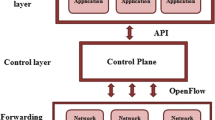Abstract
Multiplayer video streaming scenario can be seen everywhere today as the video traffic is becoming the “killer” traffic over the Internet. The Quality of Experience fairness is critical for not only the users but also the content providers and ISP. Consequently, a QoE fairness adaptive method of multiplayer video streaming is of great importance. Previous studies focus on client-side solutions without network global view or network-assisted solution with extra reaction to client. In this paper, a pure network-based architecture using SDN is designed for monitoring network global performance information. With the flexible programming and network mastery capacity of SDN, we propose an online Q-learning-based dynamic bandwidth allocation algorithm Q-FDBA with the goal of QoE fairness. The results show the Q-FDBA could adaptively react to high frequency of bottleneck bandwidth switches and achieve better QoE fairness within a certain time dimension.











Similar content being viewed by others
References
Akhshabi S, Anantakrishnan L, Begen AC, Dovrolis C (2012) What happens when HTTP adaptive streaming players compete for bandwidth?. In Proceedings of the 22nd international workshop on Network and Operating System Support for Digital Audio and Video - NOSSDAV ‘12, p. 9
Akhshabi S, Anantakrishnan L, Dovrolis C, Begen AC (2013) Server-based traffic shaping for stabilizing oscillating adaptive streaming players. Proceeding 23rd ACM Work. Netw. Oper. Syst. Support Digit. Audio Video - NOSSDAV ‘13, pp. 19–24
Bentaleb A, Begen AC, Zimmermann R (2016) SDNDASH. In Proceedings of the 2016 ACM on Multimedia Conference - MM ‘16, pp. 1296–1305
Bian J, Yang Y, Chua TS (2014) Predicting trending messages and diffusion participants in microblogging network[C]// 37th international ACM SIGIR conference on Research and Development in information retrieval, SIGIR 2014. Assoc Comput Mach:537–546
Bian J, Yang Y, Zhang H et al (2015) Multimedia summarization for social events in microblog stream[J]. IEEE Trans Multimedia 17(2):216–228
Bouten N, Latré S, Famaey J, Van Leekwijck W, De Turck F (2014) In-Network quality optimization for adaptive video streaming services
Chen J, Rodrigo P (2016) Achieving QoE fairness in video streaming via client-network interaction
Georgopoulos P, Elkhatib Y, Broadbent M, Mu M, Race N (2015) Towards network-wide QoE fairness using openflow-assisted adaptive video streaming. In Proceedings of the 2013 ACM SIGCOMM workshop on future human-centric multimedia networking - FhMN ‘13, 2013, no. November, p. 15
Huang T-Y, Johari R, McKeown N, Trunnell M, Watson M (2014) A buffer-based approach to rate adaptation: evidence from a large video streaming service. Proc. 2014 ACM Conf. SIGCOMM, pp 187–198
Jiang J (2014) Improving fairness, efficiency, and stability in HTTP-based adaptive video streaming with festive. IEEE/ACM Trans Networking 22(1):326–340
Kleinrouweler JW, Cabrero S, van der Mei R, Cesar P (2015) A model for evaluating sharing policies for network-assisted HTTP adaptive streaming. Comput Netw 109:234–245
Kreutz D, Ramos FMV, Esteves Verissimo P, Esteve Rothenberg C, Azodolmolky S, Uhlig S (2015) Software-defined networking: a comprehensive survey. Proc IEEE 103(1):14–76
Li B, Wang ZHI, Liu J, Zhu W (2013) Two decades of Internet video streaming : a retrospective view. ACM Tomccap 9(1):1–20
Li Z et al (2014) Probe and adapt: rate adaptation for HTTP video streaming at scale. IEEE J Sel Areas Commun 32(4):719–733
Liu C, Bouazizi I, Gabbouj M (2011) Rate adaptation for adaptive HTTP streaming. In Proceedings of the second annual ACM conference on Multimedia systems - MMSys ‘11, p. 169
Mok RKP, Luo X, Chan EWW, Chang RKC (2012) QDASH:A QoE-aware DASH system, In Proceedings of the 3rd Multimedia Systems Conference on - MMSys ‘12, p. 11
Nam H, Kim KH, Kim JY, Schulzrinne H (2014) Towards QoE-aware video streaming using SDN. In 2014 I.E. global communications conference. GLOBECOM 2014:1317–1322
Petrangeli S, Famaey J, Claeys M, Latré S, De Turck F (2015) QoE-driven rate adaptation heuristic for fair adaptive video streaming. ACM Trans Multimed Comput Commun Appl 12(2):1–24
Spiteri K, Urgaonkar R, Sitaraman RK (2016) BOLA: near-optimal bitrate adaptation for online videos. Proc. - IEEE INFOCOM, vol. 2016–July
Sutton RS, Barto AG (1998) Reinforcement learning: an introduction. IEEE Trans Neural Netw 9(5):1054–1054
Stockhammer T (2011) Dynamic adaptive streaming over HTTP -Standards and Design Principles. In Proceedings of the second annual ACM conference on Multimedia systems - MMSys ’11, vol 2014. ACM Press, New York, p 133
Uzakgider T, Cetinkaya C, Sayit M (2015) Learning-based approach for layered adaptive video streaming over SDN. Comput Netw 92:357–368
Xu X, He L, Lu H, et al. (2016) Non-linear matrix completion for social image tagging[J]. IEEE Access, PP(99):1–1
Xu X, He L, Shimada A et al (2016) Learning unified binary codes for cross-modal retrieval via latent semantic hashing[J]. Neurocomputing 213:191–203
Yang Y, Yang Y, Shen HT (2013) Effective transfer tagging from image to video[J]. ACM Trans Multimed Comput Commun Appl 9(2):14
Yang Y, Yang Y, Shen HT et al (2013) Discriminative nonnegative spectral clustering with out-of-sample extension[J]. IEEE Trans Knowl Data Eng 25(8):1760–1771
Yang Y, Gao Y, Zhang H, et al. (2014) Image tagging with social assistance[C]// international conference on multimedia retrieval. ACM:81
Yang Y, Shen F, Shen HT et al (2015) Robust discrete spectral hashing for large-scale image semantic indexing[J]. IEEE Trans Big Data 1(4):162–171
Yang Y, Shen F, Huang Z, et al. (2016) A unified framework for discrete spectral clustering[J]. Int Joint Con Artificial Intell (IJCAI)
Yin X, Jindal A, Sekar V, Sinopoli B (2015) A Control-Theoretic Approach for Dynamic Adaptive Video Streaming over HTTP. ACM SIGCOMM Comput Commun Rev 45(4):325–338
Yin X, Bartulović M, Sekar V, Sinopoli B (2016) On the efficiency and fairness of multiplayer HTTP-based adaptive video streaming
Acknowledgements
This work is funded by: National Sci-Tech Support Plan of China under Grant No. 2014BAH02F03, and by Youth Science Foundation of Jilin Province of China under Grant No. 20160520011JH, and by Youth Sci-Tech innovation leader and team project of Jilin Province of China under GrantNo. 20170519017JH
Author information
Authors and Affiliations
Corresponding author
Rights and permissions
About this article
Cite this article
Jiang, J., Hu, L., Hao, P. et al. Q-FDBA: improving QoE fairness for video streaming. Multimed Tools Appl 77, 10787–10806 (2018). https://doi.org/10.1007/s11042-017-4917-1
Received:
Revised:
Accepted:
Published:
Issue Date:
DOI: https://doi.org/10.1007/s11042-017-4917-1




